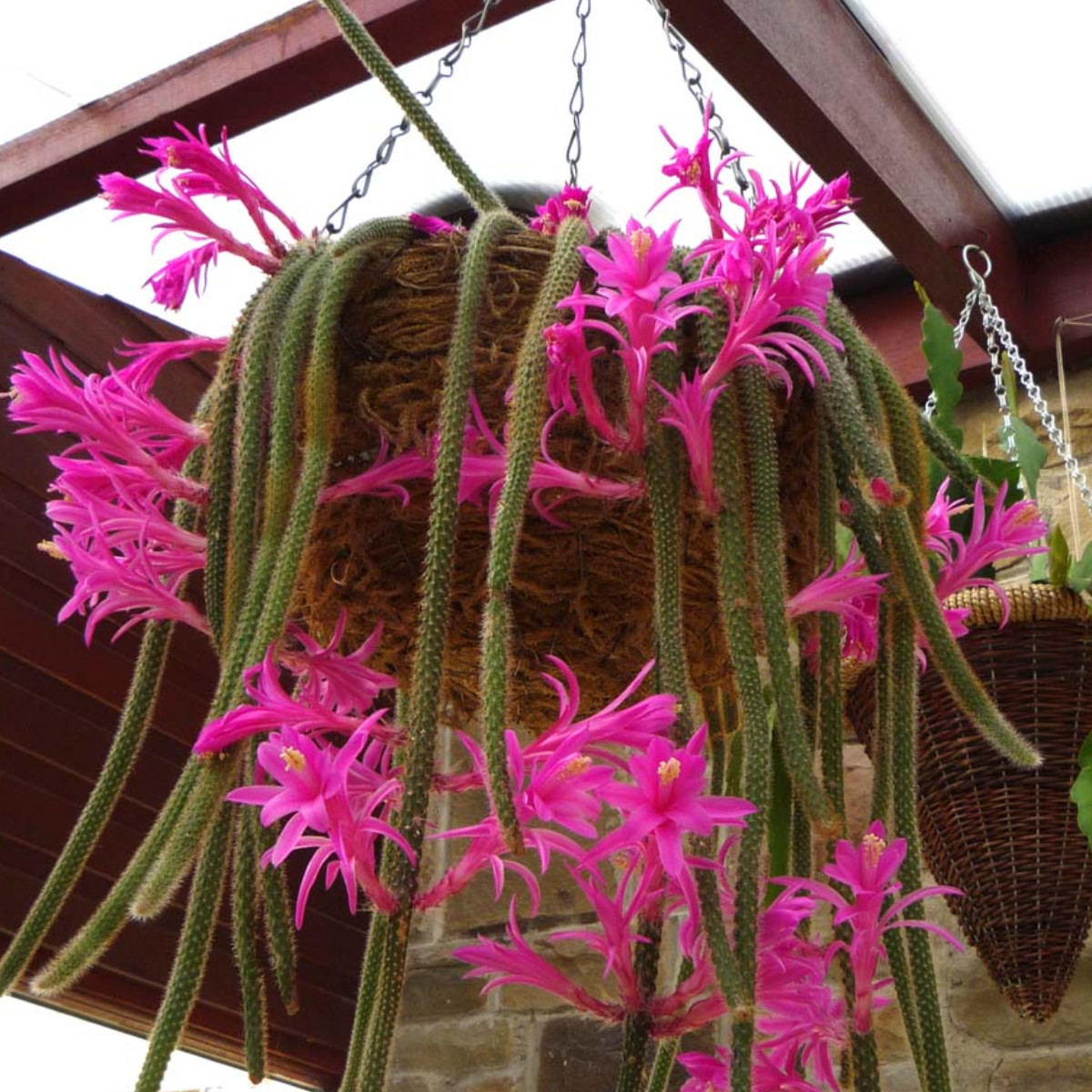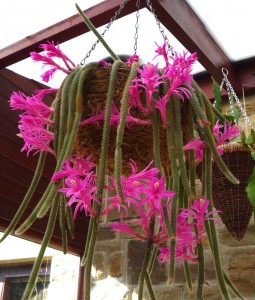Common name: Rattail Cactus
Family: Cactaceae
Synonymous: Aporocactus flagelliformis
Aporocactus flagriformis
Aporocactus leptophis
Cereus flegelliformis
Cereus flagriformis
Disocactus flagelliformis
Distribution and habitat: Aporocactus flagelliformis is lithophytic or epiphytic cactus native to southern Mexico and Central American deserts. In its natural habitat is found trailing or pendent, often epiphytic over rocks or up in trees.
Description: Aporocactus flagelliformis is an epifhitic cacti which has pendant stems that can grow up to 1.5m (5 feet) long and 2cm (0.8 inch) thick in course of only five years. Each of these bright green stems has 8 to 12 narrow, low ribs separated by broad, slightly raised areoles carry clusters of brownish spines, each about 3mm (0.1 inch) long. Tubular, crimson-pink flowers about 5cm (2 inch) long and 2.5cm (1 inch) wide appears on mature growth.
Flowers are produced profusely in spring. The flowering season lasts for about two months and individual blooms can last for several says.
Houseplant care: Their trailing stems make these cacti ideal plants for a hanging basket. Line the basket with sphagnum moss before filling it with potting mixture and make sure it is hung where the prickly stems will not pose a treat to the unwary. If Aporocactus flagelliformis is grown in a pot, hang the pot up or attache it to a high shelf. If it is left free-standing, it can soon be overbalanced by the lengthening stems.
This cactus has spines; use extreme caution when handling.
Light: Aporocactus flagelliformis requires full sunlight. Hang the pot or basket in the sunniest window available. If possible, hang the plant outdoors in summer to give it fresh air and extra light.
Temperature: During the active growth period normal room temperatures are suitable. In winter these plants should be rested at 7-10C (45-50F), if possible, but they tolerate temperatures up to 15-16C (59-61F).
Water: During the active growth period water plentifully, keeping the potting mixture thoroughly moist, but do not let plants stand in water. During the winter rest period just keep the mixture from drying out.
Feeding: Use half-strength liquid fertiliser sprayed on to the stems of the plant once every two weeks during the active growth period only.
Potting and repotting: Aporocactus flagelliformis likes a fairly rich potting mixture - ideally a combination of two-thirds soil-based mixture and one-third leaf mould. If leaf mould is not available, use old milled cow manure or commercial orchid compost. Since the plant is fast-growing, it should be repotted annually - preferably when it has finished flowering, but not necessarily in a larger container. The main reason for repotting is to provide the plant with fresh potting mixture; for Aporocactus flagelliformis use up nutrients swiftly. Use a container one size larger only when the current container is full of roots. Maximum convenient size is likely to be a 23cm (9 inch) baskets or 15cm (6 inch) pot. If a plant has outgrown such a container, it should be discarded and restarted from a cutting.
Propagation: To propagate, use either 15cm (6 inch) tip or 15cm (6 inch) segment of any part of the stem. Allow each cutting or segment to dry for three days; then insert it about 2cm (0.8 inch) deep in a small pan or pot of the recommended potting mixture for mature plants; be sure that any stem segment is planted with the bottom end down. If this shallowly inserted cutting tends to fall over, it can be supported by being gently tied to a small wooden stick. Cultivation needs of cuttings are the same as those for mature Aporocactus flagelliformis and rooting will occur within a few weeks.
These plant can also be grown from seed.
Uses: Aporocactus flagelliformis is suitable for growing indoors, in containers. It is drought-tolerant make it suitable for xeriscaping.
SUMMARY:
CHARACTERISTICS:
Foliage green
Features flowers
Shape climbing and trailing
Length: 1.5m (5 feet)
PROPER CARE:
Watering in rest period sparingly
Watering in active growth period plentifully
Light direct
Temperature in rest period min 7C max 10C (45-50F)
Temperature in active growth period min 16C max 24C (61-75F)
Humidity Low
Hardiness zone: 10a-11
Begonia propagation f...
Essential Nutrients f...
Portulacaria afra
Tillandsia recurvata
Tillandsia stricta
Columnea microphylla
Clivia miniata
Cleyera japonica
Clerodendrum thomsoni...
Cleistocactus strausi...



